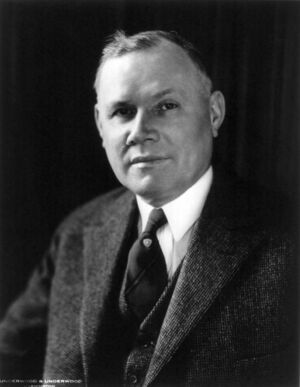Difference between revisions of "William Green"
(sections) |
m |
||
| Line 13: | Line 13: | ||
==Background == | ==Background == | ||
| − | Born into a family of coal miners in [[Ohio]], he too became one William Green became involved in [[unionism]] and became a local, then national leader of the [[United Mine Workers of America]], the miners' federation. | + | Born into a family of coal miners in [[Ohio]], he too became one William Green became involved in [[unionism]] and became a local, then national leader of the [[United Mine Workers of America]], the miners' federation. |
| − | == | + | == Career == |
| − | 1914]] | + | In [[1914]] Green joined the executive board of the [[American Federation of Labor]] and in [[1916]] he became assistant treasurer. His intensive involvement in labor had him serve as one of five delegates to the [[Paris Peace Conference]] in [[1918]]. |
When [[Samuel Gompers]] died in [[1924]], he was elected president of the AFL. His presidency is marked by an uncompromising opposition to [[communism]] and the defense of traditional American values and [[craft unionism]], against the industrial unionism defended by the [[Congress of Industrial Organizations]]. | When [[Samuel Gompers]] died in [[1924]], he was elected president of the AFL. His presidency is marked by an uncompromising opposition to [[communism]] and the defense of traditional American values and [[craft unionism]], against the industrial unionism defended by the [[Congress of Industrial Organizations]]. | ||
Latest revision as of 16:02, 9 January 2023
(union leader) | |
|---|---|
 | |
| Born | 3 March 1873 |
| Died | 1952 (Age 79) |
| Nationality | US |
William Green was the second president of the American Federation of Labor from 1924 to 1952.
Contents
Background
Born into a family of coal miners in Ohio, he too became one William Green became involved in unionism and became a local, then national leader of the United Mine Workers of America, the miners' federation.
Career
In 1914 Green joined the executive board of the American Federation of Labor and in 1916 he became assistant treasurer. His intensive involvement in labor had him serve as one of five delegates to the Paris Peace Conference in 1918.
When Samuel Gompers died in 1924, he was elected president of the AFL. His presidency is marked by an uncompromising opposition to communism and the defense of traditional American values and craft unionism, against the industrial unionism defended by the Congress of Industrial Organizations.
In 1933, Green's endeavors persuaded President Franklin D. Roosevelt to appoint him to the Labor Advisory Council of the National Recovery Administration. The following year, Green served on the National Labor Board. President Harry Truman appointed Green to the National Advisory Committee on Mobilization during the Korean War[1].
Death
He died in 1952 and was replaced at the head of the AFL by George Meany, who soon merged AFL with CIO to AFL-CIO.